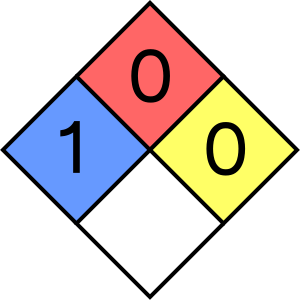POTASSIUM CHLORIDE
Basic information
- Chemical formula(s): \({\rm KCl}\)
- Other names: Muriate of potash, potassium muriate, sylvite
- CAS number: 7447-40-7
- EC number: 231-211-8
- Molecular weight: 74.55 g/mol
- International Chemical Safety Card (ICSC): 1450
- Flammability: no
- Description: White crystalline solid salt. Highly soluble in water. Not classified as hazardous under GHS regulations.
NFPA 704 (fire diamond)

- Health (blue): 1 - poses no health hazard, requires no precautions, and would offer no hazard beyond that of ordinary combustible materials.
- Flammability (red): 0 - will not burn under typical fire conditions.
- Instability–reactivity (yellow): 0 - normally stable, even under fire exposure conditions, and is not reactive with water.
- Special notice (white): -
Hazard statements
Potassium chloride is not classified as a hazardous substance according to GHS (Globally Harmonized System). Therefore, no H-codes are assigned.
| Code | Phrase |
|---|---|
| - | No hazard statements assigned |
Precautionary statements
Despite not being classified as hazardous, the following precautionary measures are recommended for safe handling:
| Code | Phrase |
|---|---|
| P261 | avoid breathing dust/fume/gas/mist/vapours/spray |
| P264 | wash hands thoroughly after handling |
| P280 | wear protective gloves/protective clothing/eye protection/face protection |
| P302+P352 | IF ON SKIN: wash with plenty of water |
| P304+P340 | IF INHALED: remove person to fresh air and keep comfortable for breathing |
| P305+P351+P338 | IF IN EYES: rinse cautiously with water for several minutes, remove contact lenses if present and easy to do, continue rinsing |
Protective measures
Gloves
For routine handling of potassium chloride powder or solutions:
- Nitrile: good - suitable for routine handling and protection from dust.
- Natural latex or rubber: good - adequate for normal contact.
- PVC: fair - suitable for basic protection.
- Leather work gloves: poor - not recommended for chemical handling.
Safety goggles
- Wear safety glasses with side shields when handling powder to prevent eye irritation from dust.
- Corrective glasses are not considered safety goggles.
- Standard safety glasses adequate for routine use.
Clothing
- Wear long sleeves and long pants to minimize skin contact with dust.
- Standard laboratory clothing is sufficient.
- Remove contaminated clothing and wash before reuse.
- Closed-toe shoes required.
Respiratory protection
- Ensure adequate ventilation when handling large quantities.
- Use dust mask if working with fine powder in poorly ventilated areas.
- N95 respirator recommended for handling large quantities of fine powder.
Spill management
- Use standard cleanup procedures for non-hazardous materials.
- Sweep up or vacuum material and place in appropriate waste container.
- Avoid creating dust clouds during cleanup.
- Use water to dampen material if dusty conditions exist.
- Clean area with water after material removal.
- Dispose according to local waste management regulations.
- No special disposal requirements - can typically be disposed as non-hazardous waste.
Special warnings
- Generally recognized as safe (GRAS) - potassium chloride is used as a food additive and salt substitute.
- Low toxicity - oral LD50 in rats: 2600 mg/kg, indicating low acute toxicity.
- May cause mild irritation - dust may cause minor irritation to eyes, skin, or respiratory tract.
- Hygroscopic - absorbs moisture from air, store in tightly closed containers.
- Store in cool, dry place away from moisture.
- Compatible with most materials - no significant incompatibilities under normal conditions.
- Large ingestion may cause gastrointestinal irritation - though this is unlikely in laboratory quantities.